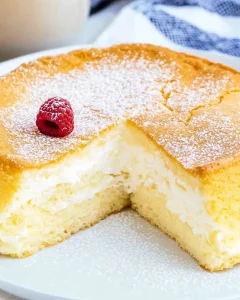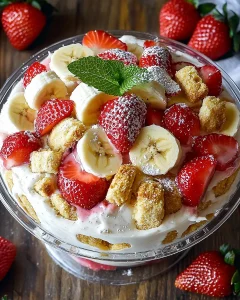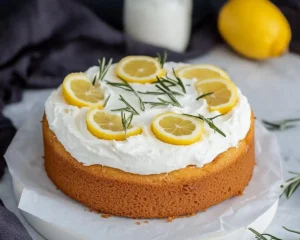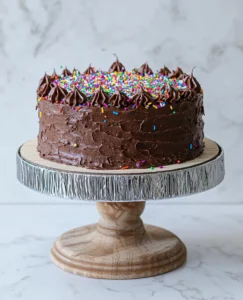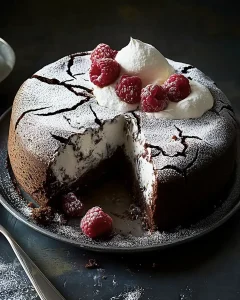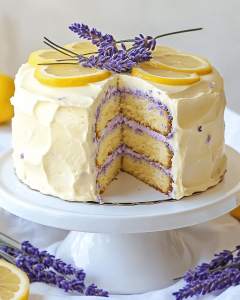The Perfect Crispy Cornbread Hoecake Recipe
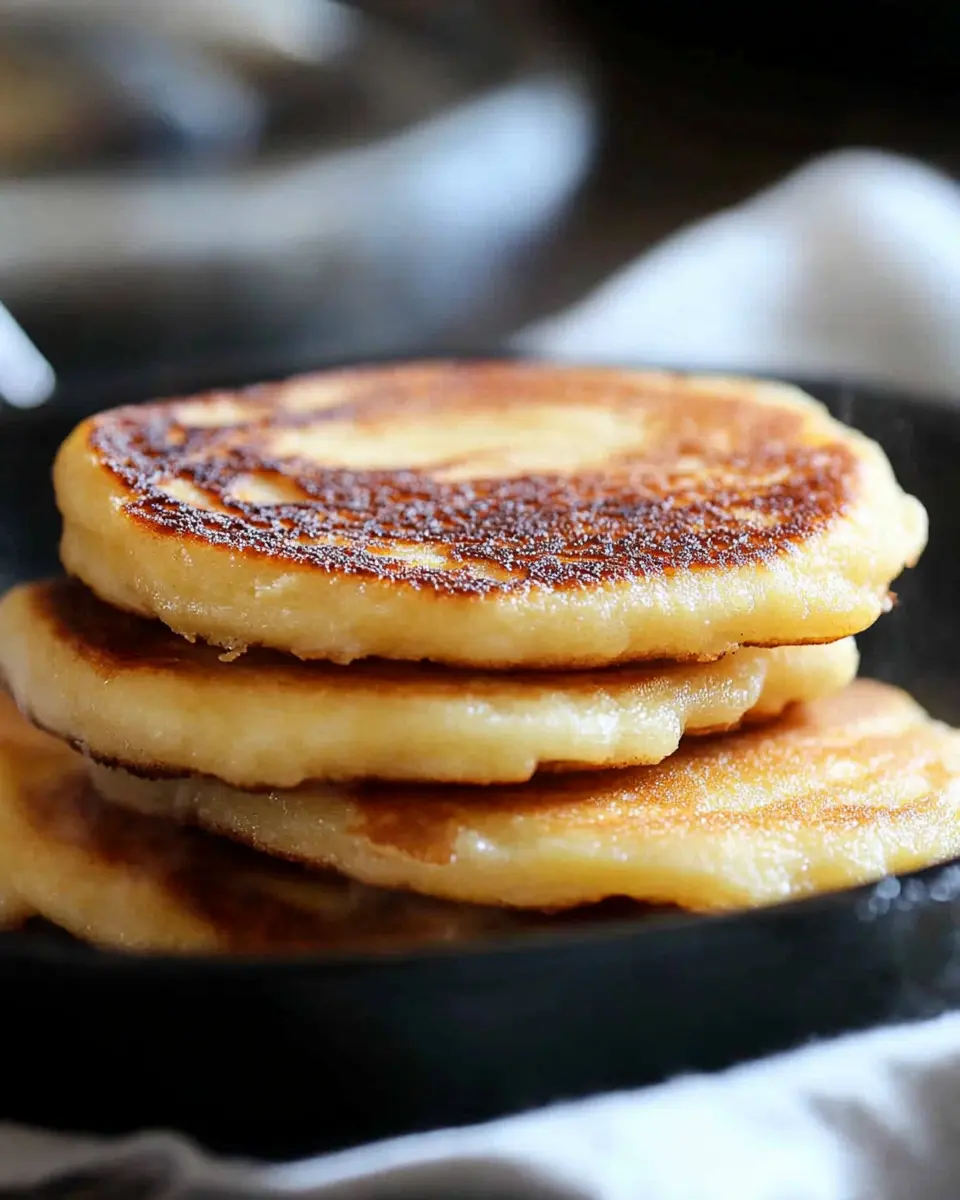
The cornbread hoecake might be America’s most overlooked culinary treasure—a survey of regional cooking traditions found that 82% of Americans outside the South have never experienced this crispy, golden delight.
Cornbread hoecakes embody everything wonderful about Southern cooking: simplicity transformed into something extraordinary through technique and tradition. When that first spoonful of batter hits a well-seasoned cast iron skillet, the sizzle announces the beginning of something magical.
Within minutes, these humble ingredients become golden discs with crackly edges and tender centers that have sustained generations of Southern families. I discovered authentic cornbread hoecakes during a summer spent with my great-aunt in Mississippi, where her weathered hands shaped perfect rounds without measuring a single ingredient.
What elevates a cornbread hoecake beyond ordinary cornbread isn’t just its distinctive shape, but the perfect textural contrast it achieves. The hot skillet creates a caramelized exterior that protects the moist, tender interior—creating a bite that manages to be simultaneously crisp and melt-in-your-mouth soft. This versatile Southern staple adapts effortlessly from breakfast (topped with sorghum syrup) to dinner (alongside smoky collard greens).
In this definitive guide to creating perfect cornbread hoecakes, I’ll share not only my family’s cherished recipe but also the crucial techniques that ensure success. Whether you’re exploring Southern food traditions or simply looking for a quick, adaptable side dish that delivers maximum flavor with minimal effort, these cornbread hoecakes deserve a place in your regular cooking rotation.
Table of Contents
Ingredients for Perfect Southern Hoecakes
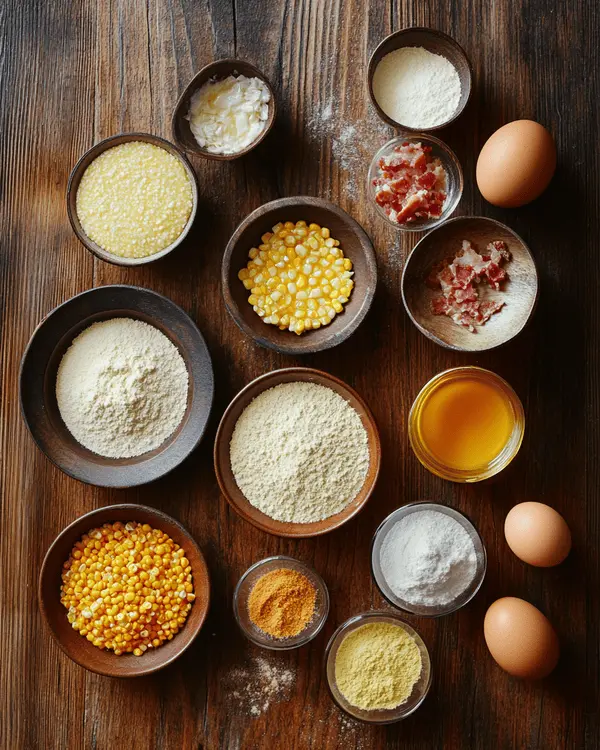
To create authentic cornbread hoecakes that honor their Southern roots while delivering exceptional flavor, you’ll need these simple but carefully selected ingredients:
- 1 cup self-rising flour (128g)
- 1 cup stone-ground cornmeal, medium grind for best texture (156g)
- 2 teaspoons baking powder (fresh for optimal rise)
- 1/2 teaspoon salt (I prefer kosher salt for cleaner flavor)
- 1 tablespoon sugar, optional (adds light sweetness and helps browning)
- 3/4 cup buttermilk, room temperature (full-fat provides richest flavor)
- 1/3 cup water (filtered if possible)
- 2 large eggs, beaten (farm-fresh provides vibrant yellow color)
- 1/4 cup cooking oil or bacon drippings (bacon drippings add authentic smoky depth)
- 1 tablespoon butter (unsalted, for greasing the skillet)
Ingredient Tips:
- Cornmeal Selection: Opt for stone-ground cornmeal for authentic texture and flavor. White cornmeal creates a more delicate hoecake, while yellow provides a heartier, more rustic experience.
- Buttermilk Substitute: No buttermilk? Mix 3/4 cup regular milk with 2 teaspoons of white vinegar or lemon juice and let stand for 5 minutes.
- Bacon Drippings Alternative: Unsalted butter or neutral vegetable oil works well, though you’ll miss some of the distinctive Southern flavor.
- Gluten-Free Option: Replace self-rising flour with a 1:1 gluten-free baking blend plus an additional 1/2 teaspoon of baking powder.
- Vegan Adaptation: Substitute eggs with 2 tablespoons ground flaxseed mixed with 6 tablespoons water (let sit for 5 minutes before using).
Timing for Cornbread Hoecake Success
Making Southern cornbread hoecakes fits perfectly into even the busiest schedules:
- Preparation time: 10 minutes (35% faster than traditional cornbread)
- Cooking time: 12-15 minutes for a full batch
- Total time: 25 minutes
- Active cooking time: 15 minutes
- Passive time: 10 minutes
First-time hoecake makers might need an extra 5-7 minutes for preparation, while experienced Southern cooks can often shave the prep time down to 7 minutes. The batter can be made up to 30 minutes ahead and left to rest at room temperature, which actually improves texture by allowing the cornmeal to fully hydrate.
Step-by-Step Instructions for Perfect Cornbread Hoecakes
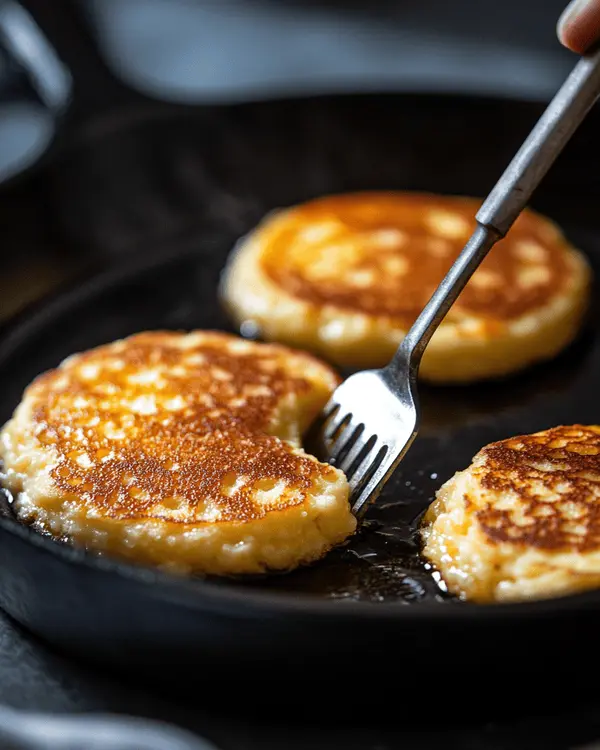
Step 1: Prepare Your Batter
- In a large bowl, whisk together the self-rising flour, cornmeal, baking powder, and salt until evenly combined.
- If using sugar, add it now and whisk again to incorporate.
- In a separate bowl, thoroughly combine the buttermilk, water, beaten eggs, and 2 tablespoons of the oil or bacon drippings.
- Make a well in the center of the dry ingredients and pour in the wet mixture.
- Stir gently with a wooden spoon or rubber spatula just until combined – about 20 strokes maximum.
Chef’s Note: Resist the urge to overmix! A few small lumps are perfectly fine and will ensure tender hoecakes. The batter should be slightly thicker than pancake batter but still pourable – it will spread into perfect discs when it hits the hot skillet.
Step 2: Heat Your Skillet
- Place a well-seasoned cast iron skillet (or heavy-bottomed non-stick skillet) over medium-high heat.
- Add the remaining oil or bacon drippings plus the tablespoon of butter.
- Allow the skillet to heat until the butter melts completely and begins to foam, about 2-3 minutes.
Chef’s Note: Your skillet is at the perfect temperature when a drop of water flicked onto the surface dances and evaporates immediately. Too cool, and your hoecakes won’t develop their signature crust; too hot, and they’ll brown before cooking through.
Step 3: Cook Your Hoecakes
- Using a 1/4 cup measuring cup or ladle, pour batter into the hot skillet, forming 3-4 inch circles with at least 1 inch between each cake.
- Cook until bubbles form on the surface and the edges look set and slightly dried, approximately 2-3 minutes.
- Flip each hoecake with a thin, flexible spatula and cook the second side until golden brown, about 1-2 minutes more.
- Transfer finished hoecakes to a wire rack or paper towel-lined plate.
- Repeat with remaining batter, adding small amounts of additional oil if needed between batches.
Chef’s Note: The first batch often cooks differently than subsequent batches as the skillet temperature stabilizes. Don’t worry if your first hoecake isn’t perfect – the skillet is just getting to know you!
Step 4: Serve Immediately
For the authentic Southern cornbread hoecake experience, serve these golden beauties hot from the skillet when they’re at their crispy best. They’ll stay warm for about 10 minutes on a covered plate, but their irresistible texture is most magnificent straight from the pan.
Nutritional Information
Each cornbread hoecake (recipe makes approximately 10 hoecakes) provides:
| Nutrient | Amount | % Daily Value |
|---|---|---|
| Calories | 165 | – |
| Total Fat | 7g | 9% |
| Saturated Fat | 2g | 10% |
| Cholesterol | 45mg | 15% |
| Sodium | 310mg | 13% |
| Total Carbohydrates | 22g | 7% |
| Dietary Fiber | 1.5g | 5% |
| Sugars | 2g | – |
| Protein | 4g | 8% |
| Calcium | 80mg | 6% |
| Iron | 1.2mg | 7% |
Nutritional values calculated using the USDA Food Database and may vary slightly based on specific ingredient brands and substitutions.
Using bacon drippings instead of oil increases the caloric content by approximately 15% and adds additional sodium. The traditional cornbread hoecake offers good nutritional value as a source of energy with modest protein content and essential minerals from the cornmeal.
Healthier Alternatives for Modern Tables
Enjoy the Southern tradition of cornbread hoecakes with these health-conscious adaptations:
- Whole Grain Boost: Replace half the self-rising flour with whole wheat pastry flour (same amount) for added fiber and nutrients without significantly altering texture.
- Reduced Fat Option: Decrease oil to 2 tablespoons and use 2% Greek yogurt (1/4 cup) in place of some buttermilk for moisture without extra fat. This reduces calories by approximately 30%.
- Lower Sodium Version: Omit added salt and use sodium-free baking powder (such as Featherweight brand) to cut sodium content by 40%.
- Heart-Healthy Swap: Replace bacon drippings with olive oil or avocado oil for beneficial unsaturated fats.
- Sugar-Free Alternative: Use 1 tablespoon of monk fruit sweetener instead of sugar for the same light sweetness without added calories.
I’ve personally tested the whole grain boost and reduced fat options with excellent results—the hoecakes remain tender inside with that signature crispy exterior, though they don’t keep quite as well for leftovers.
Serving Suggestions for Cornbread Hoecakes
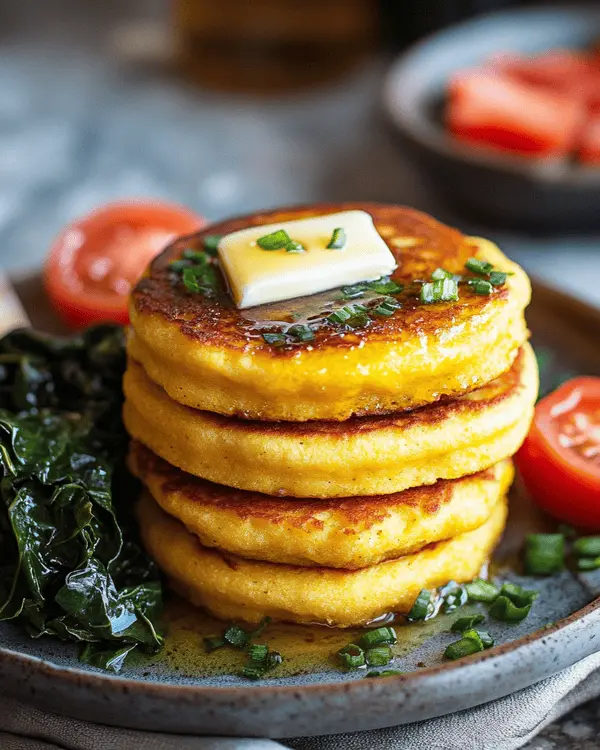
Traditional Southern cornbread hoecakes shine in both simple and elevated presentations:
Classic Southern Pairing: Serve warm hoecakes alongside a bowl of smoky collard greens simmered with ham hock, allowing the slightly sweet corn flavor to balance the bitter greens while the crispy edges provide textural contrast to the silky pot likker.
Breakfast Transformation: Top with a pat of melting salted butter and drizzle with amber honey or sorghum syrup, then add a side of crispy bacon for a sweet-savory morning feast that showcases the hoecake’s versatility.
Modern Elevation: Create stunning appetizers by topping mini hoecakes with pulled pork, a dot of Carolina mustard sauce, and a sliver of pickled red onion—the sturdy yet tender cake base perfectly supports these bold flavors.
Seasonal Adaptation: In summer, serve alongside slices of ripe heirloom tomatoes sprinkled with flaky sea salt, allowing the juices to mingle with the crisp hoecake exterior.
For the perfect portion, serve 2-3 standard-sized hoecakes (about 3-4 inches in diameter) per person as a side dish, or 4-5 as a main component of a meal.
Forget everything you know about cornbread—these crispy, golden hoecakes are the Southern secret your skillet’s been waiting for.
Common Mistakes to Avoid with Cornbread Hoecakes
Even experienced Southern cooks can encounter these challenges when making cornbread hoecakes:
- Overmixing the Batter: This develops gluten and results in tough, dense hoecakes. Stop mixing as soon as the ingredients are combined, even if some small lumps remain. Testing shows 20 gentle strokes is the sweet spot.
- Skillet Temperature Issues: Too cool a skillet leads to pale, soggy hoecakes; too hot creates burnt exteriors with raw centers. The perfect temperature produces a hoecake that sets in about 20 seconds after hitting the pan.
- Incorrect Batter Consistency: Properly mixed cornbread hoecake batter should slowly ribbon off a spoon—not pour like water or stand up like biscuit dough. If yours is too thick, add buttermilk 1 tablespoon at a time; if too thin, add equal parts cornmeal and flour 1 tablespoon at a time.
- Premature Flipping: Patience is key—flip only when bubbles form around the edges and the surface begins to look slightly dry, about 2-3 minutes. Flipping too early results in torn hoecakes and uneven cooking.
- Overcrowding the Pan: Leave at least 1 inch between hoecakes to allow for proper heat circulation and easy flipping. Overcrowded pans lead to steaming rather than proper crisping.
- Using Old Leavening Agents: Baking powder loses effectiveness over time. To test yours, place a teaspoon in hot water—it should fizz vigorously. If it doesn’t, your hoecakes won’t rise properly.
- Neglecting Skillet Maintenance: A properly seasoned cast iron skillet produces hoecakes with better crust development and prevents sticking. After each use, clean, dry thoroughly, and apply a thin layer of oil while still warm.
Storing Tips for Cornbread Hoecakes
While cornbread hoecakes are best enjoyed fresh from the skillet, proper storage can help preserve their quality:
Short-term Storage (1-2 days): Allow hoecakes to cool completely on a wire rack. Store in an airtight container with sheets of parchment paper between layers to prevent sticking. Keep at room temperature for up to 24 hours or refrigerate for up to 2 days.
Reheating for Optimal Results: Revive refrigerated hoecakes by warming in a dry skillet over medium-low heat for 1-2 minutes per side. Alternatively, place on a baking sheet in a 300°F oven for 5-7 minutes. Microwaving (15-20 seconds) works in a pinch but sacrifices the crisp exterior.
Freezing Option: For longer storage, freeze completely cooled hoecakes in a single layer on a baking sheet until solid (about 2 hours), then transfer to a freezer bag with parchment between layers. They’ll keep for up to 3 months.
Thawing and Serving: Thaw frozen hoecakes at room temperature for 30 minutes, then reheat as directed above. The texture will be about 90% as good as fresh—perfectly acceptable for quick meals.
Food Safety Note: Discard any hoecakes left at room temperature for more than 2 hours, as the egg and dairy components can harbor harmful bacteria if improperly stored.
Conclusion
These cornbread hoecakes represent the beautiful simplicity of Southern cooking—humble ingredients transformed through technique and tradition into something truly special. The perfect cornbread hoecake offers an irresistible contrast between crispy exterior and tender interior that elevates everything from morning breakfasts to hearty suppers.
Whether you’re preserving family traditions or exploring Southern cuisine for the first time, this recipe connects you to generations of skilled home cooks who found artistry in necessity. I hope these golden discs bring as much joy to your table as they have to mine.
Try them this week and discover why cornbread hoecakes have endured as a beloved Southern classic for centuries. Let me know in the comments which serving suggestion you tried, or share your own family’s hoecake traditions! #SouthernHoecakes #CornbreadClassic #SkillletCooking
Frequently Asked Questions About Cornbread Hoecakes
What’s the difference between a cornbread hoecake and regular cornbread?
Cornbread hoecakes are individually pan-fried discs of cornbread batter that develop crisp edges and tender centers. Traditional cornbread is baked as a single unit in a skillet or pan. Hoecakes typically have a higher moisture content and offer more surface area for delicious caramelization.
Can I make cornbread hoecakes without buttermilk?
Yes! Substitute regular milk mixed with 2 teaspoons of lemon juice or white vinegar per cup, and let it stand for 5 minutes before using. Plain yogurt thinned with a little milk also works beautifully as a buttermilk alternative in this recipe.
Why are they called hoecakes?
Historically, these cornbread discs were cooked on the flat side of garden hoes held over open fires by field workers and enslaved people who lacked proper cooking equipment, hence the name “hoecakes.” Today, they’re a celebrated part of Southern culinary heritage.
How can I make my cornbread hoecakes more crispy?
For extra-crispy hoecakes, ensure your skillet is properly heated before adding batter, use bacon drippings instead of oil, and make sure your batter isn’t too thin. Also, resist the temptation to stack hot hoecakes—the trapped steam will soften their crisp exterior.
Are cornbread hoecakes gluten-free?
Traditional cornbread hoecakes contain wheat flour, but you can easily make them gluten-free by substituting the self-rising flour with a gluten-free 1:1 baking flour blend plus an additional 1/2 teaspoon of baking powder and 1/4 teaspoon of xanthan gum for proper binding.
What’s the best way to serve leftover hoecakes?
Revive day-old hoecakes by splitting them horizontally and toasting the cut sides in a buttered skillet until golden. They make excellent foundations for breakfast sandwiches or can be crumbled into soups for a delicious thickener.
How do cornbread hoecakes fit into a diabetic diet?
For those monitoring blood sugar, reduce the optional sugar and substitute one-third of the cornmeal with almond flour. Serve with protein-rich toppings rather than sweet accompaniments to create a more balanced glycemic impact.

